Design of Spoke-Type Permanent Magnet Synchronous Generator for Low Capacity Wind Turbine Considering Magnetization and Cogging Torques †
Abstract
:1. Introduction
2. Spoke Type Rotor Magnetization Analysis
2.1. Principle of Magnetization
2.2. PM Magnetization Method
3. Spoke-Type PMSG Design Considering Magnetization
4. Spoke-Type PMSG Design to Reduce Cogging Torque
5. Performance Test and Results
6. Conclusions
Author Contributions
Funding
Data Availability Statement
Conflicts of Interest
References
- Ko, K.; Jang, S.; Park, J.; Cho, H.; You, D.-J. Electromagnetic Performance Analysis of Wind Power Generator w With Outer Permanent Magnet Rotor Based on Turbine Characteristics Variation Over Nominal Wind Speed. IEEE Trans. Magn. 2011, 47, 3292–3295. [Google Scholar] [CrossRef]
- Gu, Y.; Huang, Y.; Wu, Q.; Li, C.; Zhao, H.; Zhan, Y. Isolation and Protection of the Motor-Generator Pair System for Fault Ride-Through of Renewable Energy Generation Systems. IEEE Access 2020, 8, 13251–13258. [Google Scholar] [CrossRef]
- Fang, Y.; Jia, K.; Yang, Z.; Li, Y.; Bi, T. Impact of Inverter-Interfaced Renewable Energy Generators on Distance Protection and an Improved Scheme. IEEE Trans. Ind. Electron. 2019, 66, 7078–7088. [Google Scholar] [CrossRef]
- Zamani, M.H.; Riahy, G.H.; Abedi, M. Rotor-Speed Stability Improvement of Dual Stator-Winding Induction Generator-Based Wind Farms by Control-Windings Voltage Oriented Control. IEEE Trans. Power Electron. 2015, 31, 5538–5546. [Google Scholar] [CrossRef]
- Yang, X.; Patterson, D.; Hudgins, J. Permanent magnet generator design and control for large wind turbines. In Proceedings of the 2012 IEEE Power Electronics and Machines in Wind Applications (PEMWA 2012), Denver, CO, USA, 16–18 July 2012; pp. 1–5. [Google Scholar]
- Lee, J.; Seo, G.; Mun, J.; Park, M.; Kim, S. Thermal and Mechanical Design for Refrigeration System of 10 MW Class HTS Wind Power Generator. IEEE Trans. Appl. Supercond. 2020, 30, 5201905. [Google Scholar] [CrossRef]
- Chen, Y.; Pillay, P.; Khan, A. PM wind generator comparison of different topologies. In Proceedings of the 2004 IEEE Industry Applications Conference, Seattle, WA, USA, 16–18 October 2004; pp. 1405–1412. [Google Scholar]
- Khan, M.A.; Pillay, P.; Malengret, M. Impact of direct-drive WEC Systems on the design of a small PM wind generator. In Proceedings of the 2003 IEEE Bologna Power Tech Conference Proceedings, Bologna, Italy, 23–26 June 2003; p. 7. [Google Scholar]
- Wang, F.; Qingming, H.; Jianlong, B.; Jian, P. Study on control system of low speed PM generator direct driven by wind turbine. In Proceedings of the 2005 International Conference on Electrical Machines and Systems (ICEMS 2005), Nanjing, China, 27–29 June 2005; pp. 1009–1012. [Google Scholar]
- Wu, Z.; Dou, X.; Chu, J.; Hu, M. Operation and Control of a Direct-Driven PMSG-Based Wind Turbine System with an Auxiliary Parallel Grid-Side Converter. Energies 2013, 6, 3405–3421. [Google Scholar] [CrossRef]
- Kou, S.; Kou, Z.; Wu, J.; Wang, Y. Modeling and Simulation of a Novel Low Speed High-Torque Permanent Magnet Synchronous Motor with Asymmetric Stator Slots. Machines 2022, 10, 1143. [Google Scholar] [CrossRef]
- Tahanian, H.; Aliahmadi, M.; Faiz, J. Ferrite Permanent Magnets in Electrical Machines: Opportunities and Challenges of a Non-Rare earth Alternative. IEEE Trans. Magn. 2020, 56, 900120. [Google Scholar] [CrossRef]
- Zhu, X.; Wang, L.; Chen, Y.; Chen, L.; Quan, L. A Non-Rare Earth Doubly Salient Flux Controllable Motor Capable of Fault-Tolerant Control. IEEE Trans. Magn. 2015, 51, 8111204. [Google Scholar] [CrossRef]
- Barcaro, M.; Bianchi, N. Interior pm machines using ferrite to replace rare earth surface PM machines. IEEE Trans. Ind. Appl. 2014, 50, 979–985. [Google Scholar] [CrossRef]
- Fasolo, A.; Alberti, L.; Bianchi, N. Performance comparison between switching-flux and IPM machines with rare earth and ferrite PMs. IEEE Trans. Ind. Appl. 2014, 50, 3708–3716. [Google Scholar] [CrossRef]
- Morimoto, S.; Ooi, S.; Inoue, Y.; Sanada, M. Experimental Evaluation of a Rare Earth-Free PMASynRM with Ferrite Magnets for Automotive Applications. IEEE Trans. Ind. Electron. 2014, 61, 5749–5756. [Google Scholar] [CrossRef]
- Obata, M.; Morimoto, S.; Sanada, M.; Inoue, Y. Performance of PMASynRM with Ferrite Magnets for EV/HEV Applications Considering Productivity. IEEE Trans. Ind. Appl. 2014, 50, 2427–2435. [Google Scholar] [CrossRef]
- Jeong, M.J.; Lee, K.B.; Pyo, H.J.; Nam, D.W.; Kim, W.H. A Study on the Shape of the Rotor to Improve the Performance of the Spoke Type Permanent Magnet Synchronous Motor. Energies 2021, 14, 3758. [Google Scholar] [CrossRef]
- Kim, K.; Park, M.; Kim, H.; Chai, S.; Hong, J. Estimation of Rotor Type Using Ferrite Magnet Considering the Magnetization Process. IEEE Trans. Magn. 2016, 52, 8101804. [Google Scholar] [CrossRef]
- Seol, H.; Jeong, T.; Jun, H.; Lee, J.; Kang, D. Design of 3-Times Magnetizer and Rotor of Spoke Type PMSM Considering Post-Assembly Magnetization. IEEE Trans. Magn. 2017, 53, 8208005. [Google Scholar] [CrossRef]
- Lee, S.G.; Bae, J.; Kim, W. Design Process of Spoke Type Permanent Magnet Synchronous Motor Considering Magnetization Performance. IEEE Trans. Appl. Supercond. 2020, 30, 5205706. [Google Scholar] [CrossRef]
- Kim, D.-H.; Kim, S.-Y.; Song, S.-W.; Lee, J.; Kim, W.-H. Spoke type Permanent Magnet Synchronous Generator Design considering Magnetizing and Cogging Torque. In Proceedings of the 2022 IEEE Energy Conversion Congress and Exposition (ECCE), Detroit, MI, USA, 9–13 October 2003; pp. 1–6. [Google Scholar]
- Hanselman, D. Magnetic modeling. In Brushless Motors: Magnetic Design, Performance, and Control of Brushless DC and Permanent Magnet Synchronous Motors; E-Man Press LLC: New York, NY, USA, 2012; pp. 16–18. [Google Scholar]
- Kim, D.-H.; Kim, K.S.; Yang, I.-J.; Lee, J.; Kim, W.-H. Alternative Bridge Spoke Permanent Magnet Synchronous Generator Design for Wind Power Generation Systems. IEEE Access 2021, 9, 152819–152828. [Google Scholar] [CrossRef]
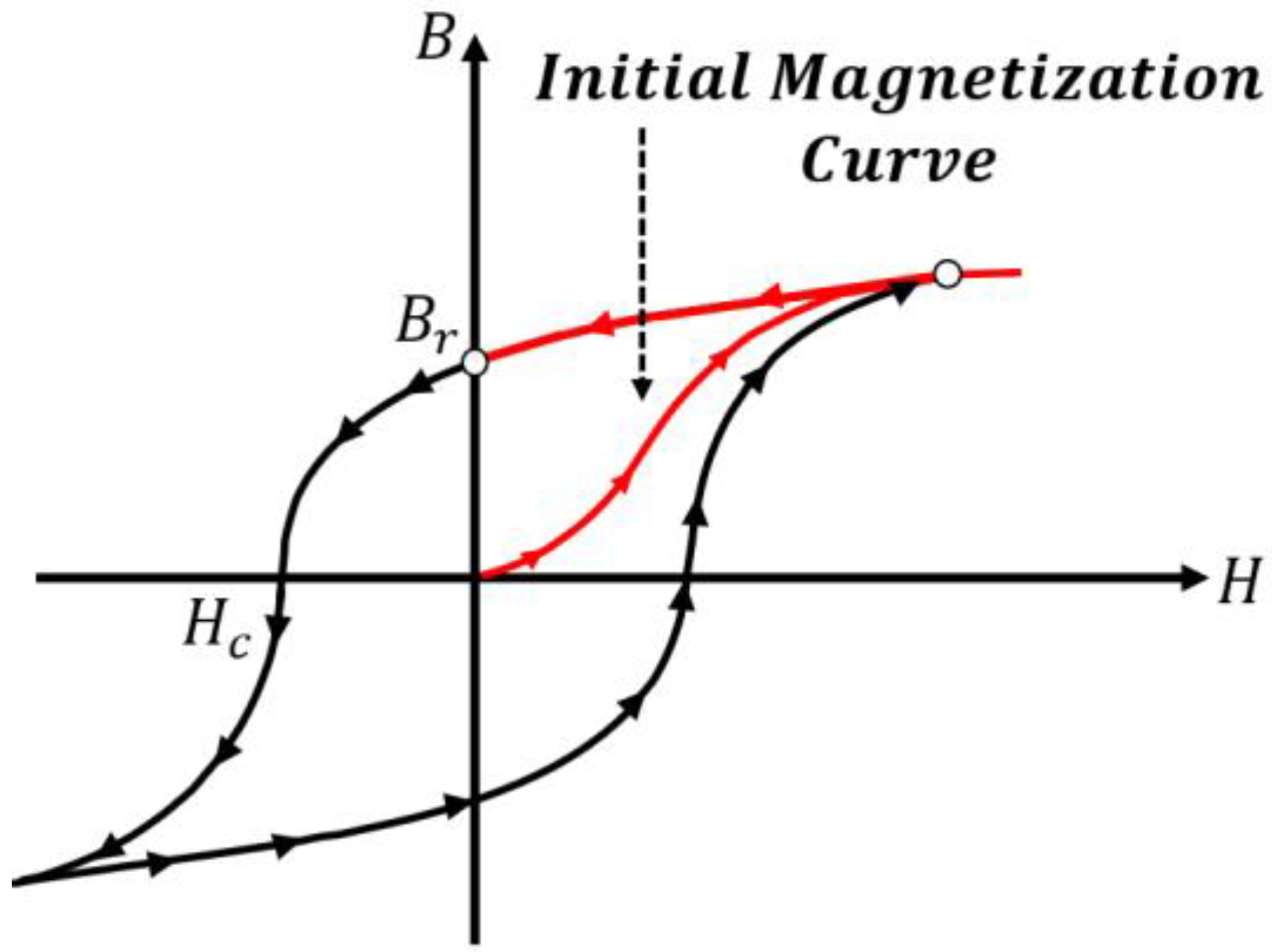


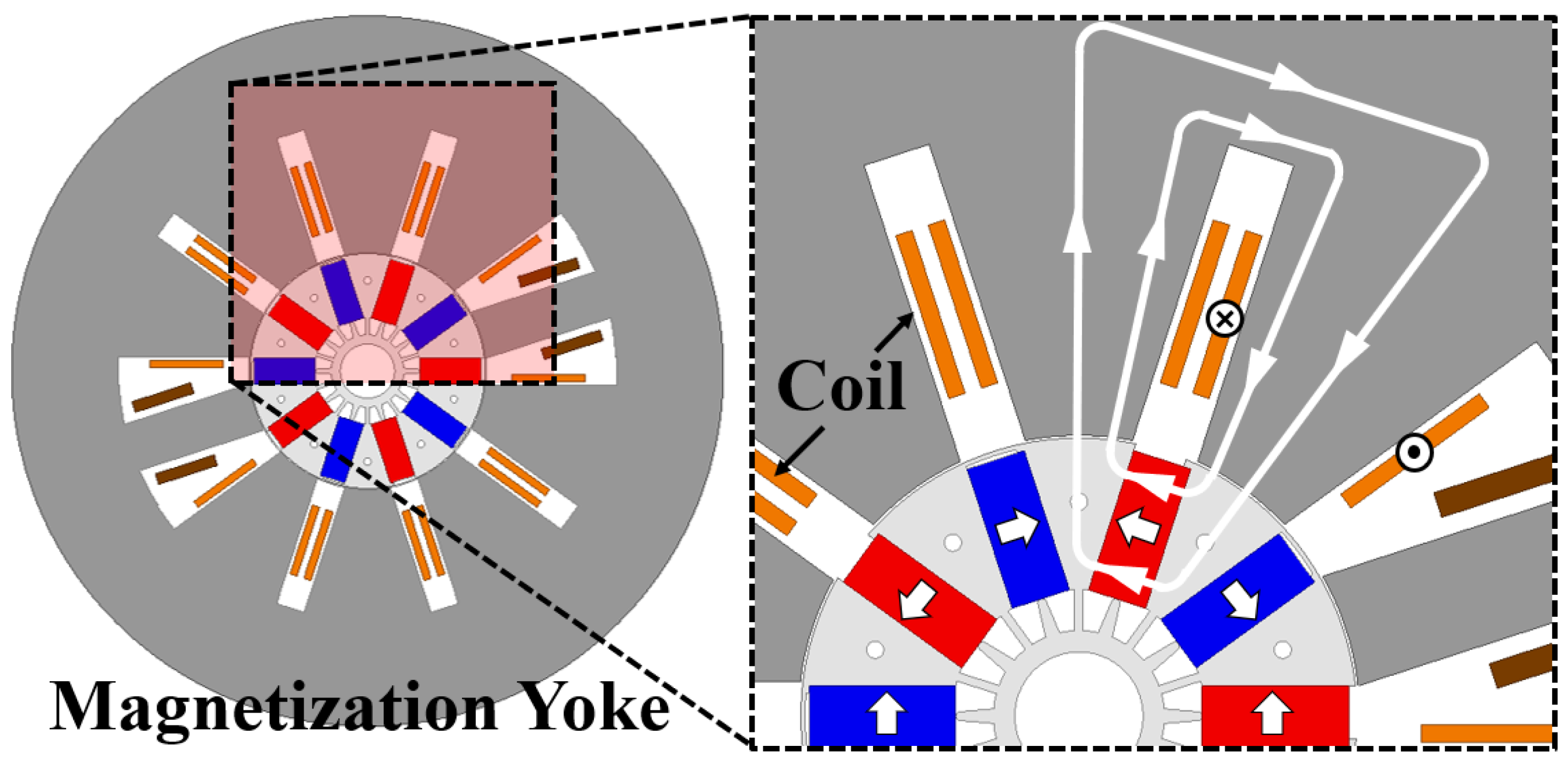
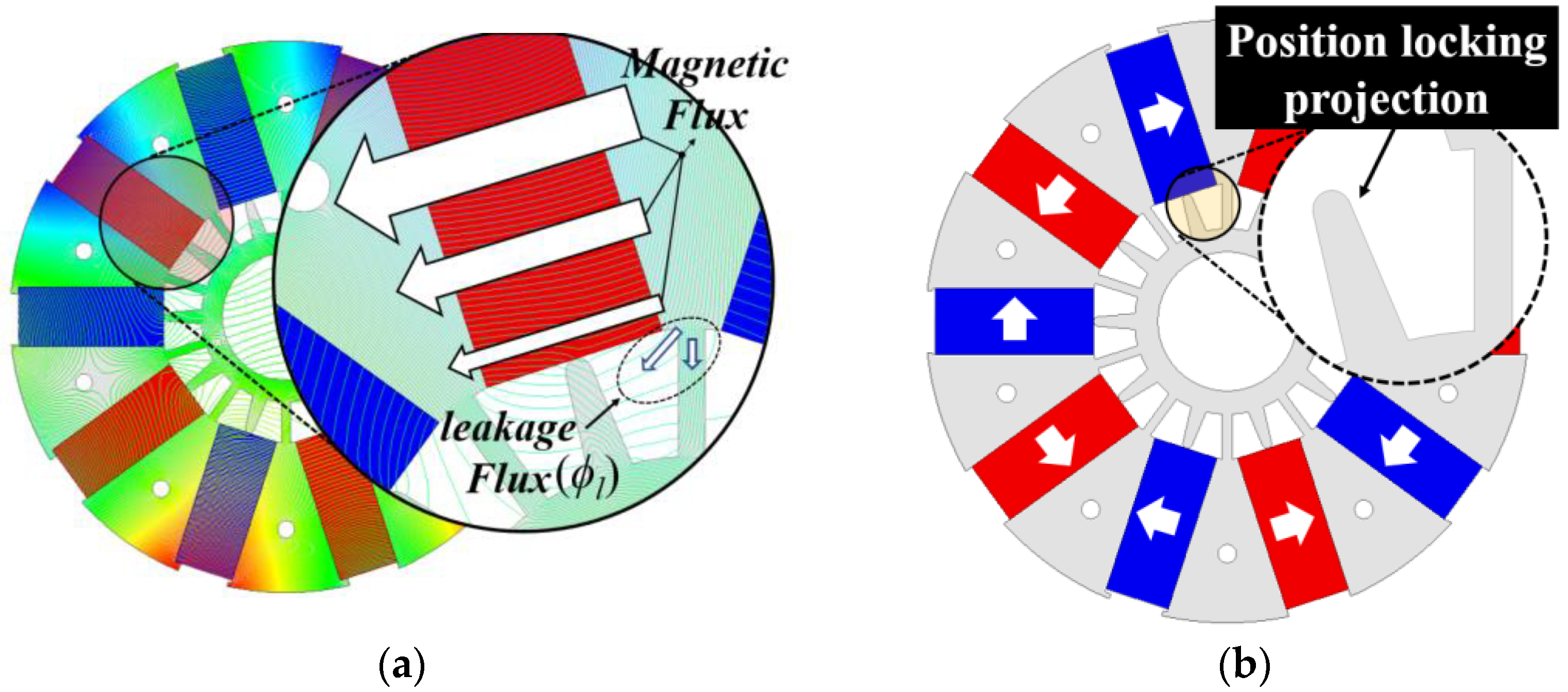

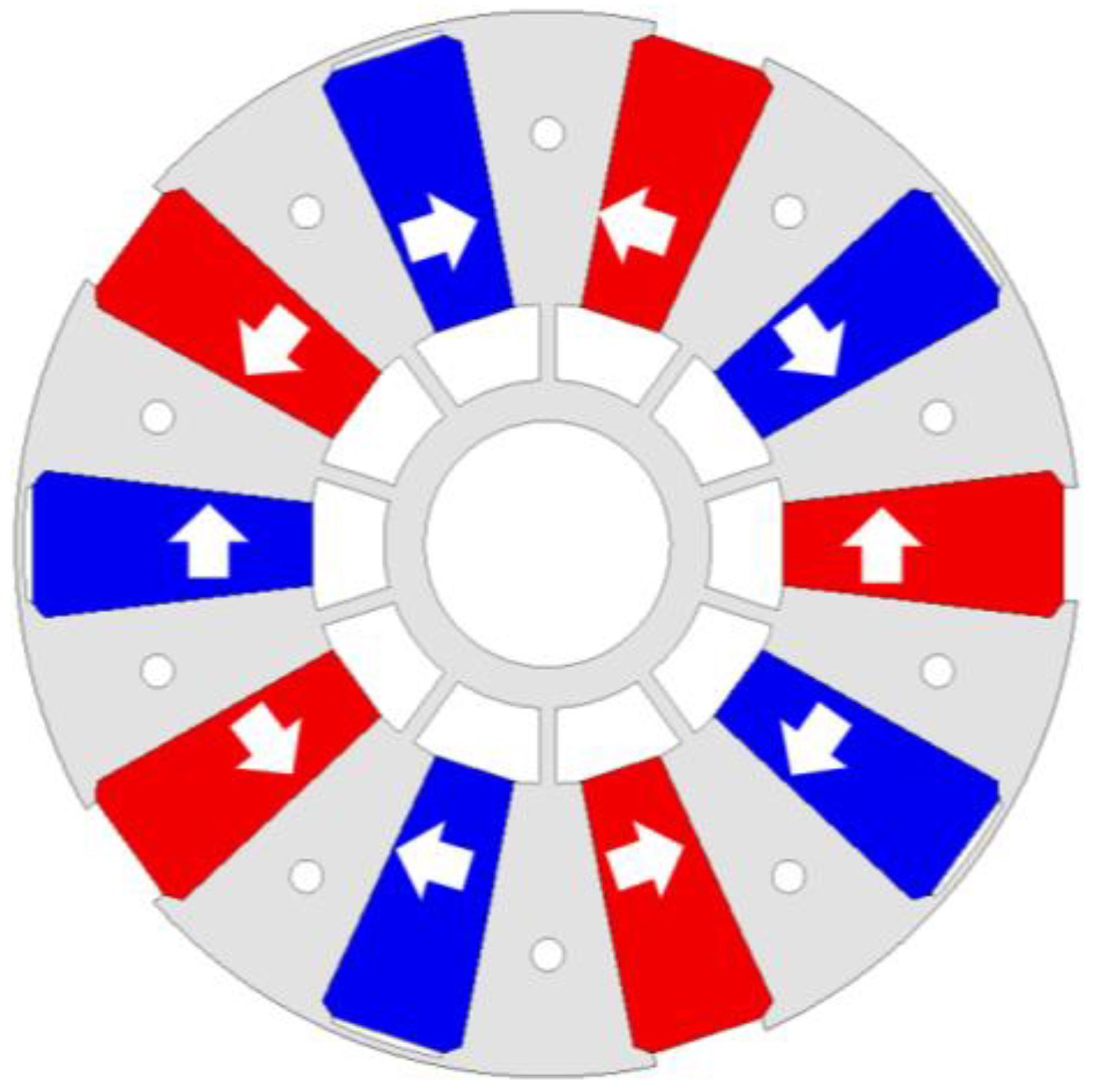
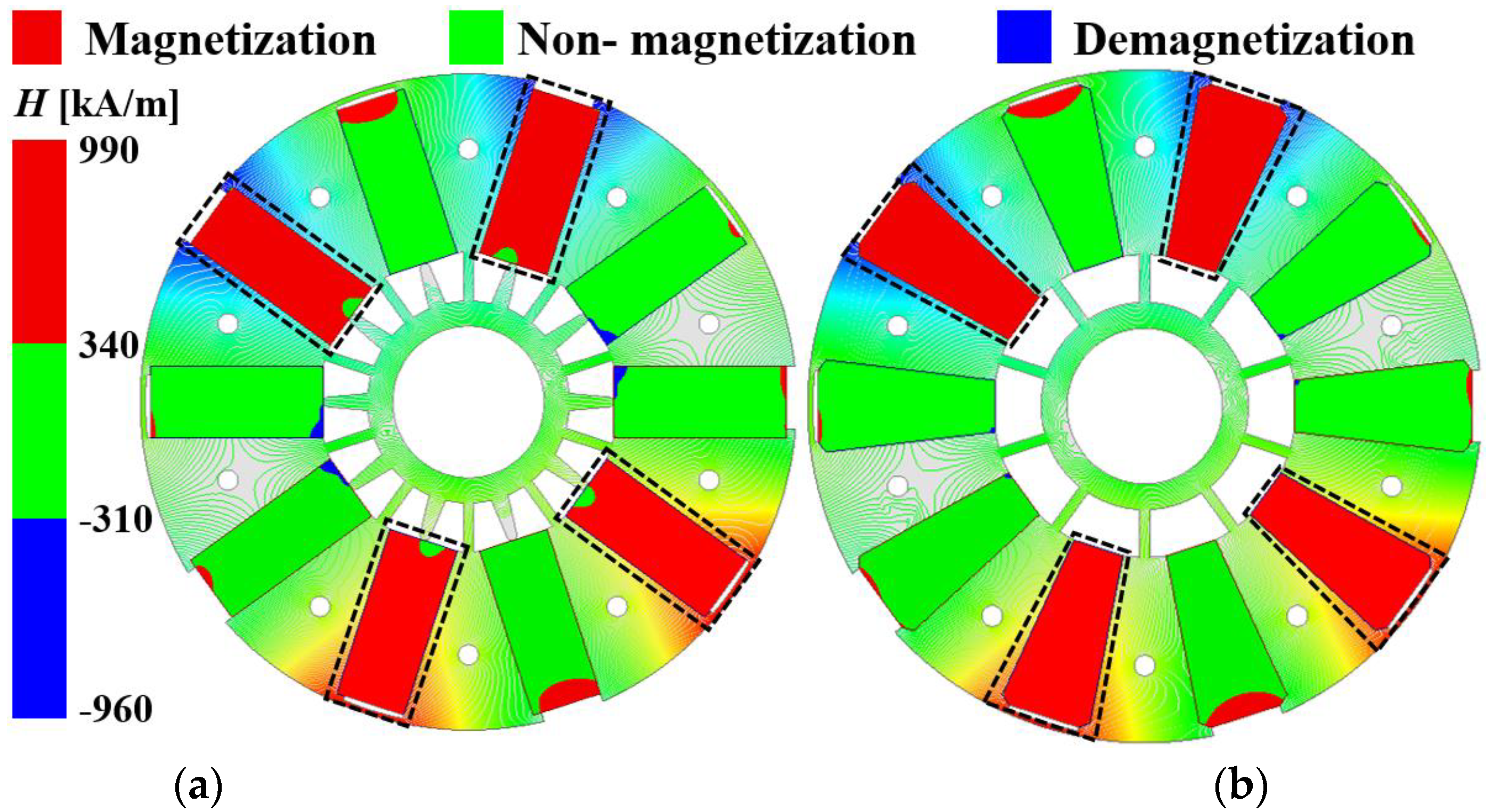

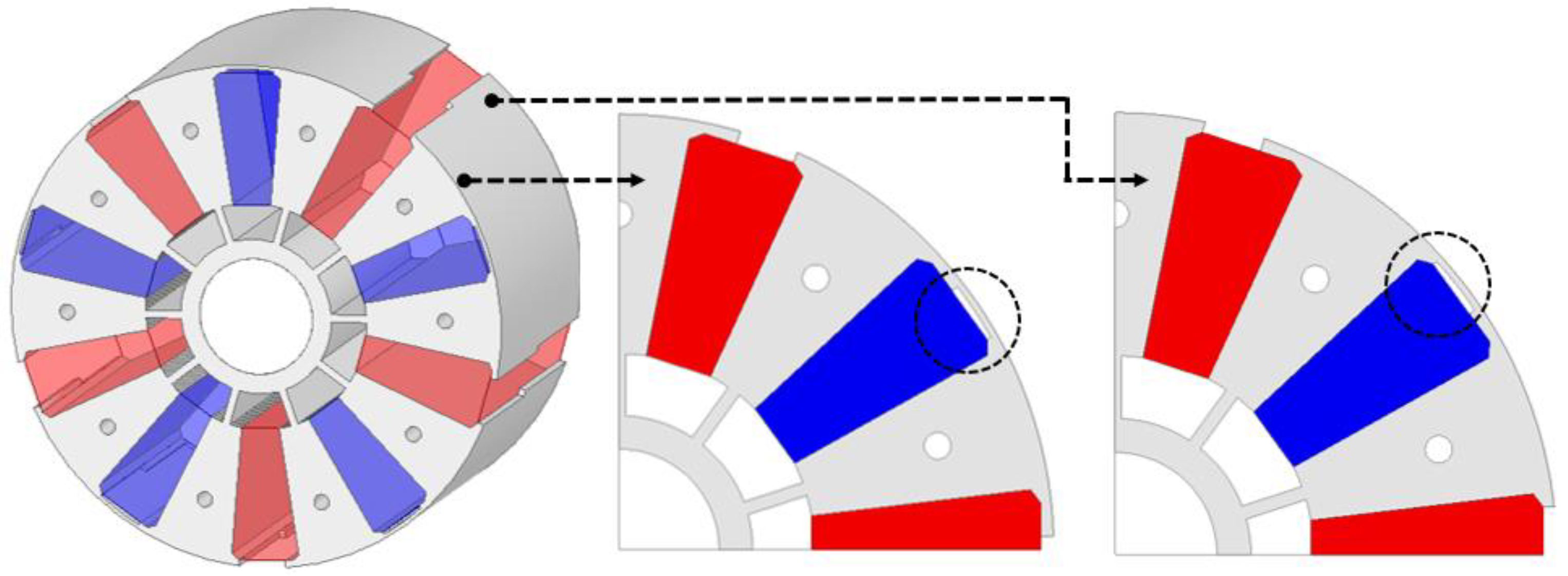
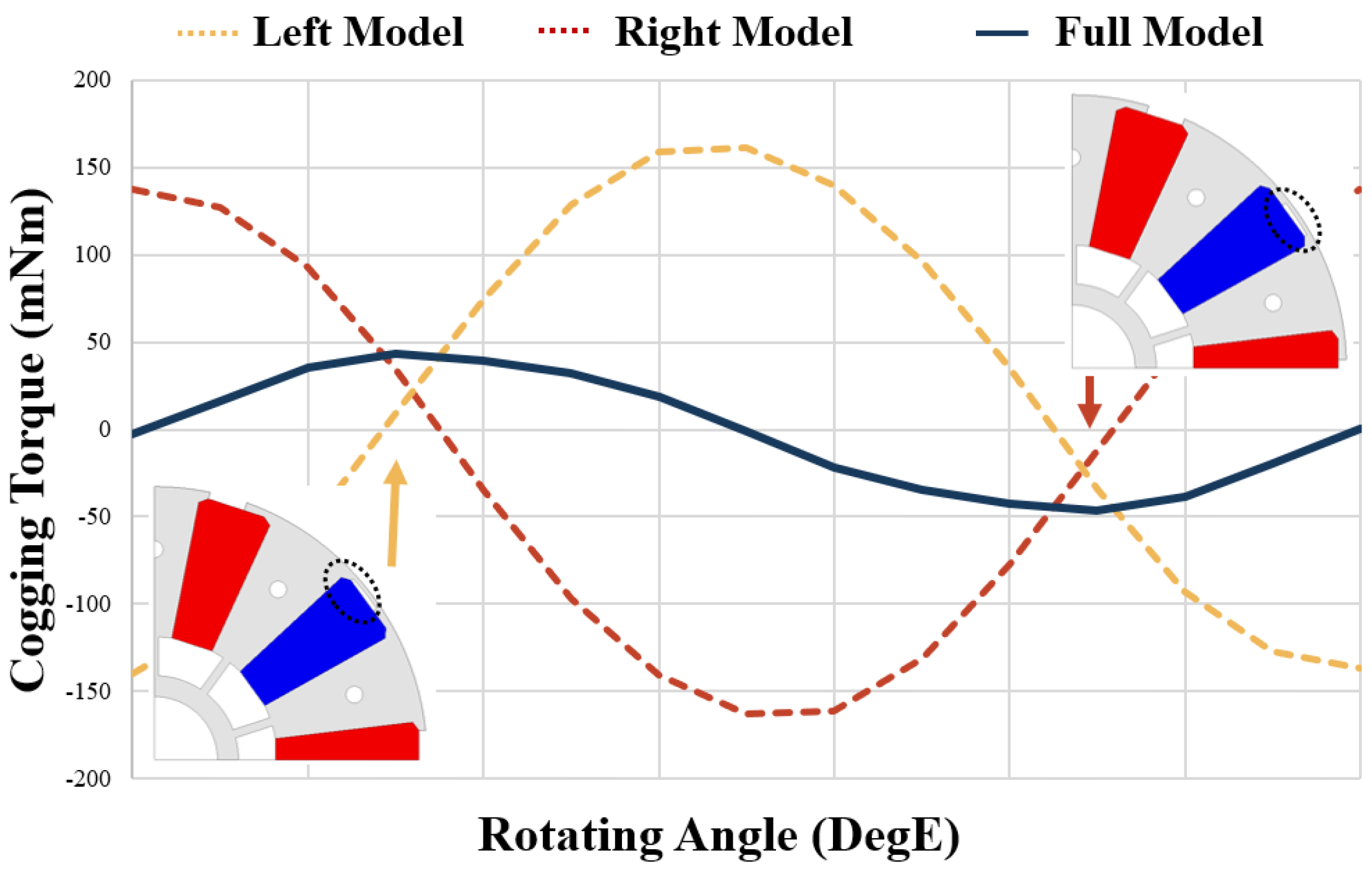
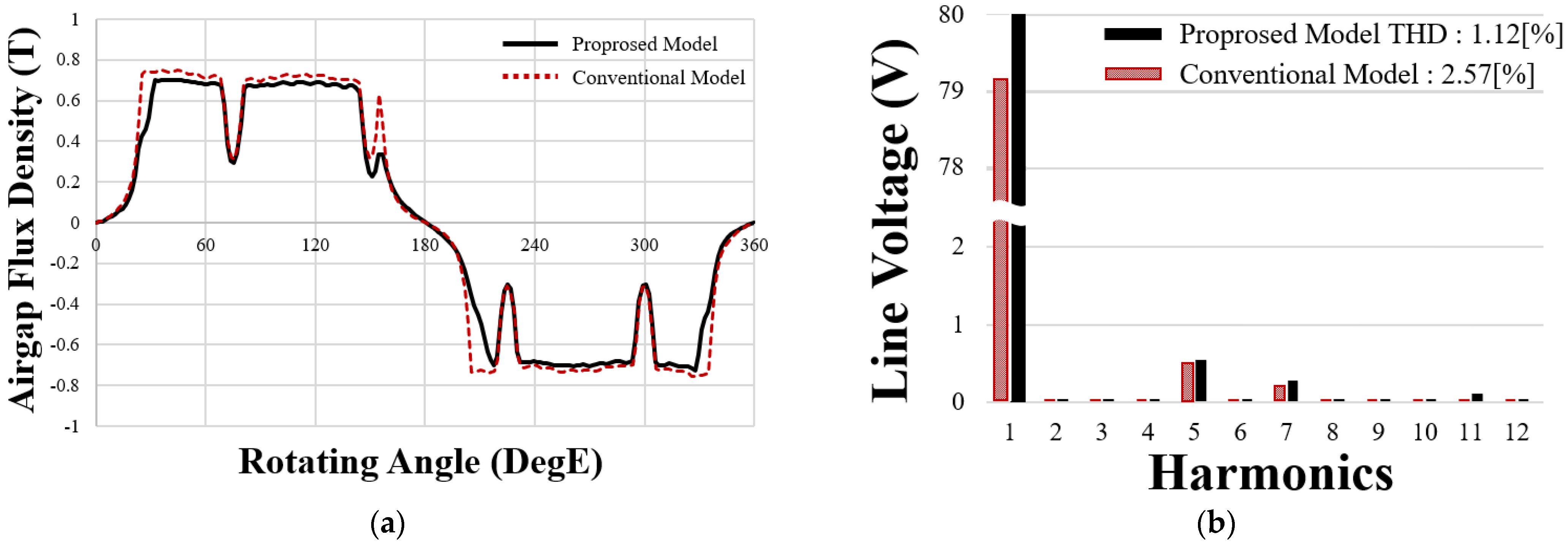
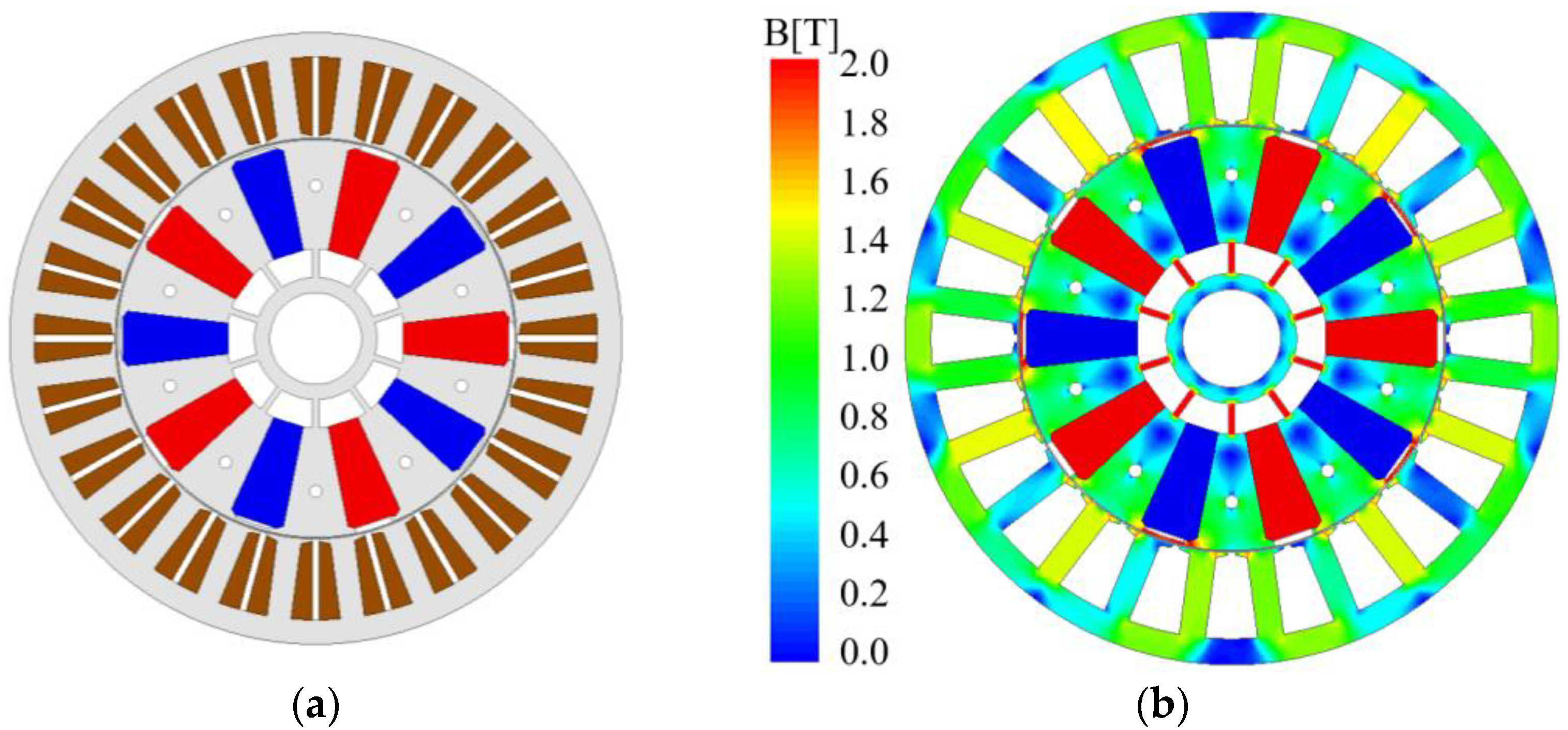
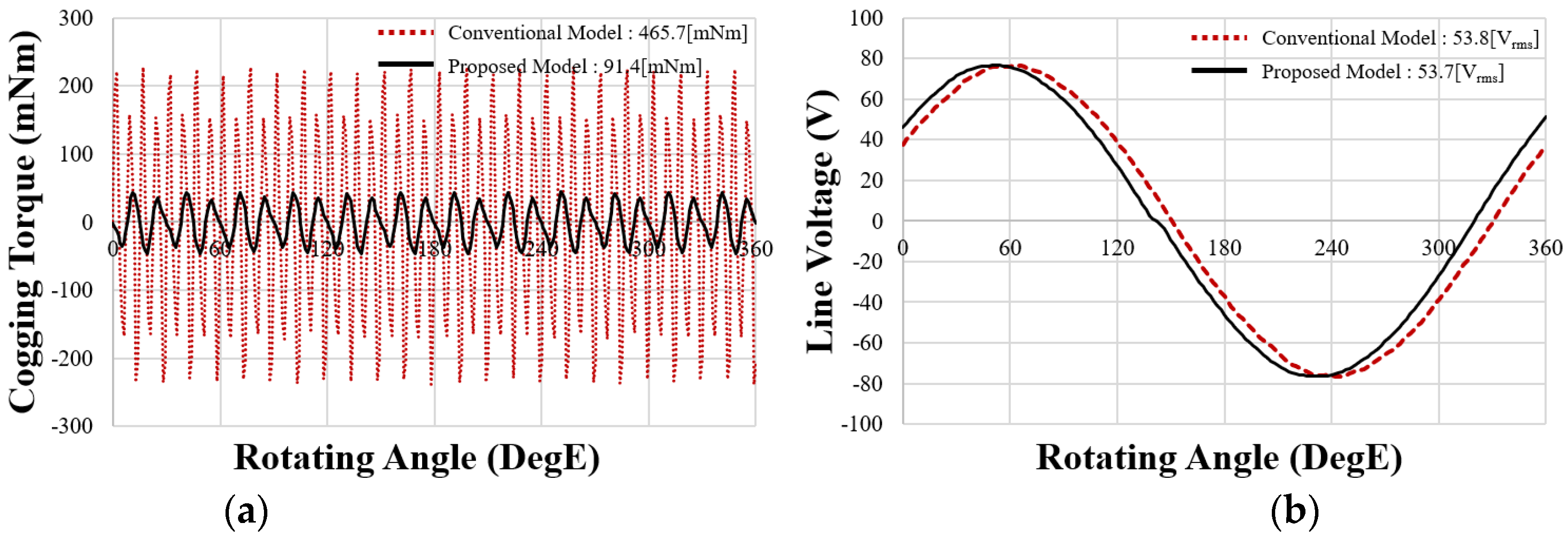

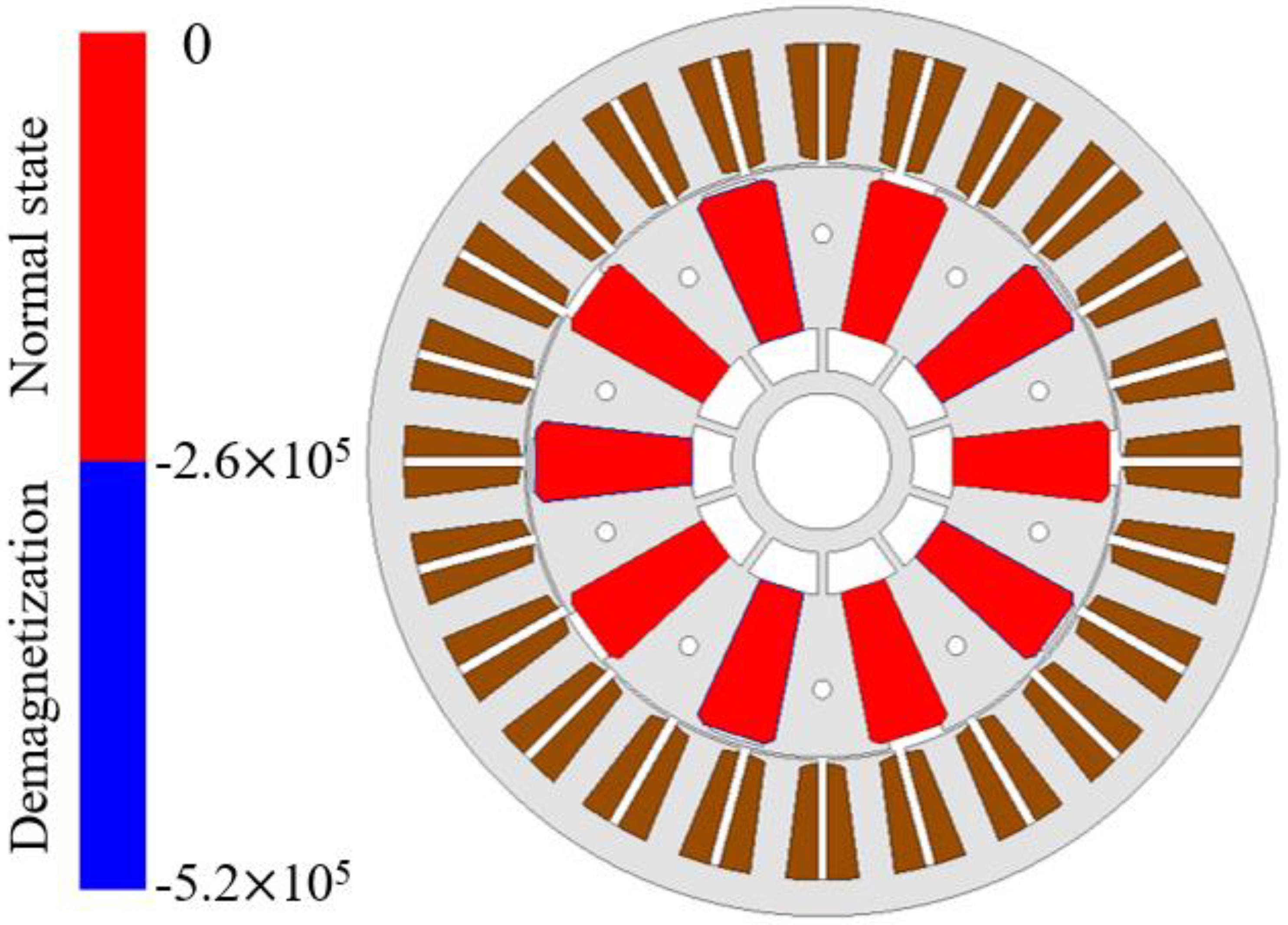
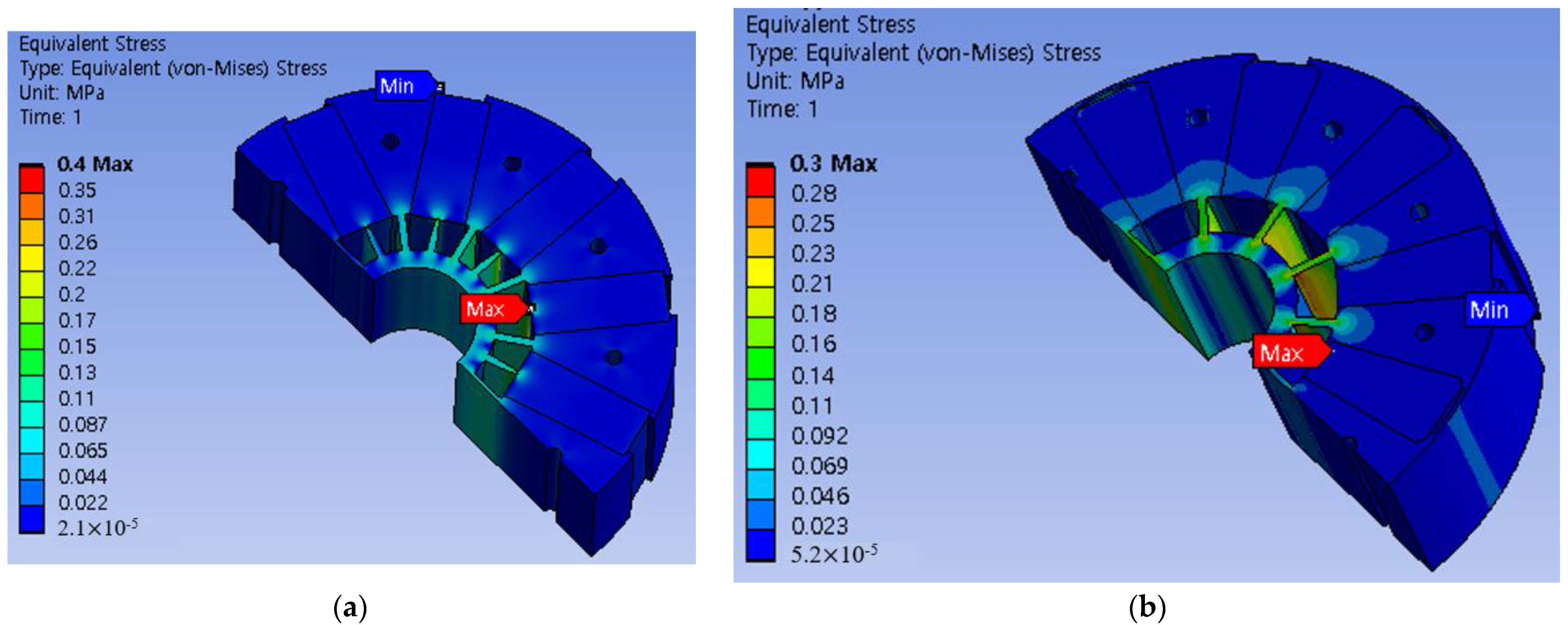
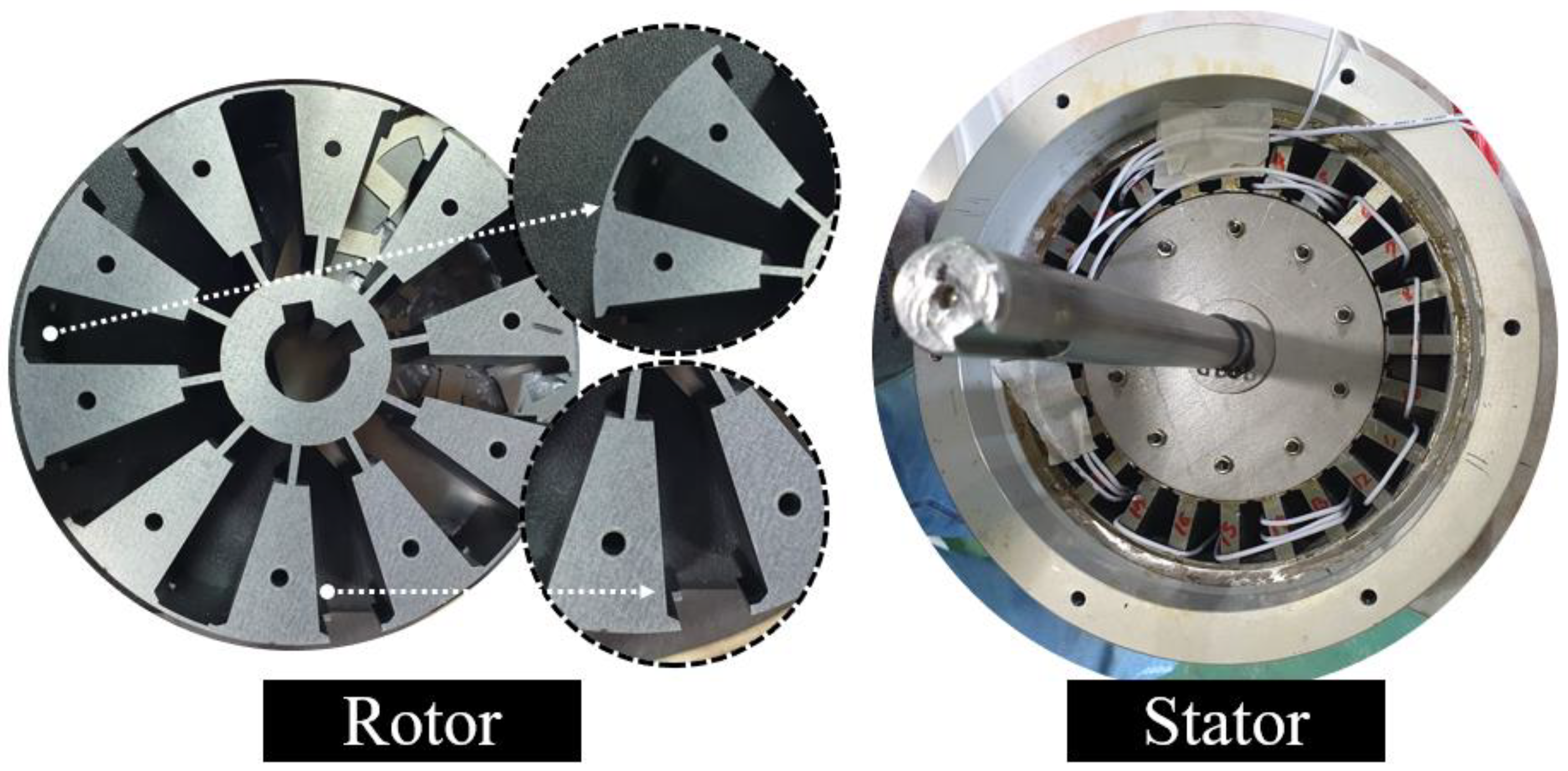
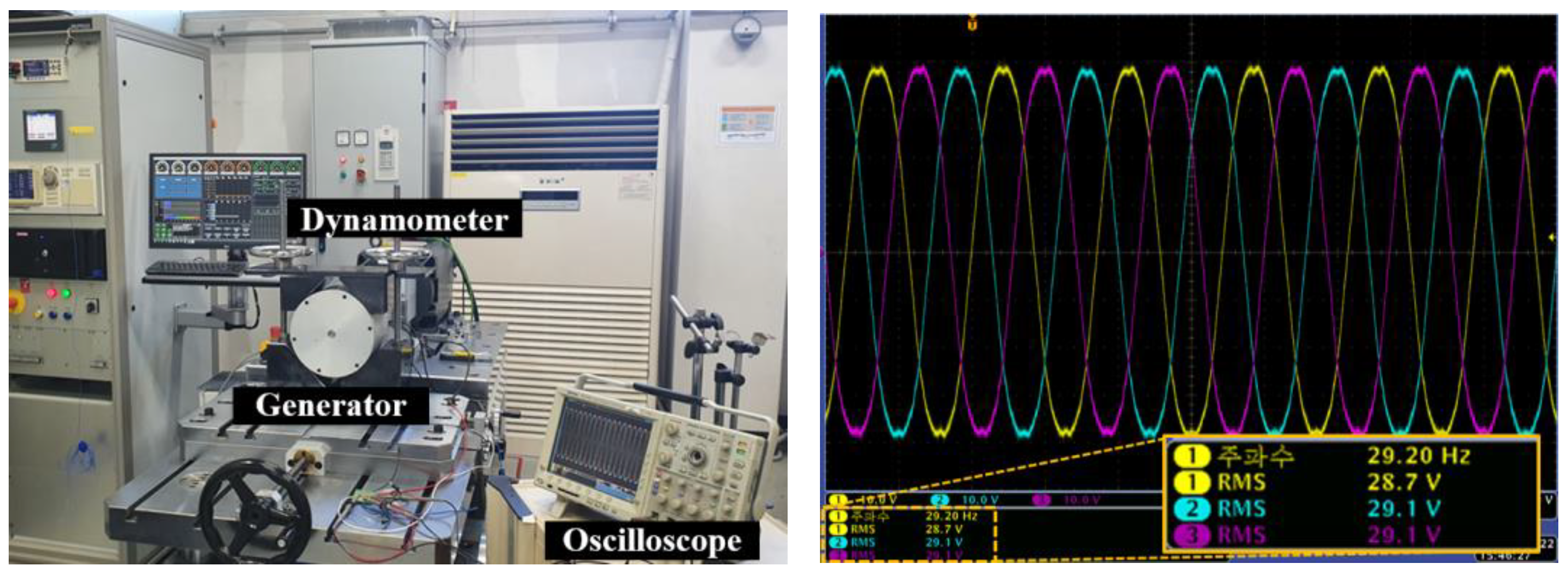
| Parameter | Value | Unit |
|---|---|---|
| Power | 500 | W |
| Cogging Torque | 410 | mNm |
| Voltage | 50 | Vrms |
| Current | 6 | Arms |
| Speed | 350 | rpm |
| Efficiency | 90 | % |
| Voltage reduction rate | 15 | % |
| THD | 5 | % |
| Parameter | Conventional Model | Proposed Model | Unit |
|---|---|---|---|
| Cogging Torque | 456.7 | 91.4 | mNm |
| Line Voltage | 56 | 56.9 | Vrms |
| THD | 2.57 | 1.12 | % |
| Parameter | 12 Slot | 24 Slot | 36 Slot | Unit |
|---|---|---|---|---|
| Cogging Torque | 502.9 | 91.4 | 77.6 | mNm |
| Line Voltage THD | 7.26 | 1.12 | 1.46 | % |
| Voltage reduction rate | 4.51 | 5.37 | 4.95 | % |
| Efficiency | 92.7 | 92.2 | 92.2 | % |
| Parameter | Conventional Model | Proposed Model | Unit |
|---|---|---|---|
| Line Voltage | 53.8 | 53.7 | Vrms |
| Torque | 14.3 | 14.1 | Nm |
| Torque ripple | 1.7 | 1.2 | Nm |
| Current | 5.6 | 5.6 | Arms |
| Core loss | 11 | 9.7 | W |
| Copper loss | 32.5 | 34.8 | W |
| Output Power | 526.8 | 523.1 | W |
| Efficiency | 92.4 | 92.2 | % |
| Voltage reduction rate | 3.8 | 5.4 | % |
| Cogging Torque | 465.7 | 91.4 | mNm |
| THD | 2.57 | 1.1 | % |
| Parameter | FEA | Test | Unit |
|---|---|---|---|
| Voltage (No Load) | 31.0 | 29.1 | Vrms |
| Line Voltage (No Load) | 56.9 | 53.6 | Vrms |
| Line Voltage (Load) | 53.7 | 52.5 | Vrms |
| Torque | 14.1 | 14.3 | Nm |
| Current | 5.6 | 5.9 | Arms |
| Output Power | 523.1 | 535.5 | W |
| Efficiency | 92.2 | 91.6 | % |
| Voltage reduction rate | 5.4 | 6.9 | % |
| THD | 1.1 | 0.49 | % |
Disclaimer/Publisher’s Note: The statements, opinions and data contained in all publications are solely those of the individual author(s) and contributor(s) and not of MDPI and/or the editor(s). MDPI and/or the editor(s) disclaim responsibility for any injury to people or property resulting from any ideas, methods, instructions or products referred to in the content. |
© 2023 by the authors. Licensee MDPI, Basel, Switzerland. This article is an open access article distributed under the terms and conditions of the Creative Commons Attribution (CC BY) license (https://creativecommons.org/licenses/by/4.0/).
Share and Cite
Kim, D.-H.; Pyo, H.-J.; Kim, W.-H.; Lee, J.; Lee, K.-D. Design of Spoke-Type Permanent Magnet Synchronous Generator for Low Capacity Wind Turbine Considering Magnetization and Cogging Torques. Machines 2023, 11, 301. https://doi.org/10.3390/machines11020301
Kim D-H, Pyo H-J, Kim W-H, Lee J, Lee K-D. Design of Spoke-Type Permanent Magnet Synchronous Generator for Low Capacity Wind Turbine Considering Magnetization and Cogging Torques. Machines. 2023; 11(2):301. https://doi.org/10.3390/machines11020301
Chicago/Turabian StyleKim, Dong-Ho, Hyun-Jo Pyo, Won-Ho Kim, Ju Lee, and Ki-Doek Lee. 2023. "Design of Spoke-Type Permanent Magnet Synchronous Generator for Low Capacity Wind Turbine Considering Magnetization and Cogging Torques" Machines 11, no. 2: 301. https://doi.org/10.3390/machines11020301
APA StyleKim, D.-H., Pyo, H.-J., Kim, W.-H., Lee, J., & Lee, K.-D. (2023). Design of Spoke-Type Permanent Magnet Synchronous Generator for Low Capacity Wind Turbine Considering Magnetization and Cogging Torques. Machines, 11(2), 301. https://doi.org/10.3390/machines11020301







